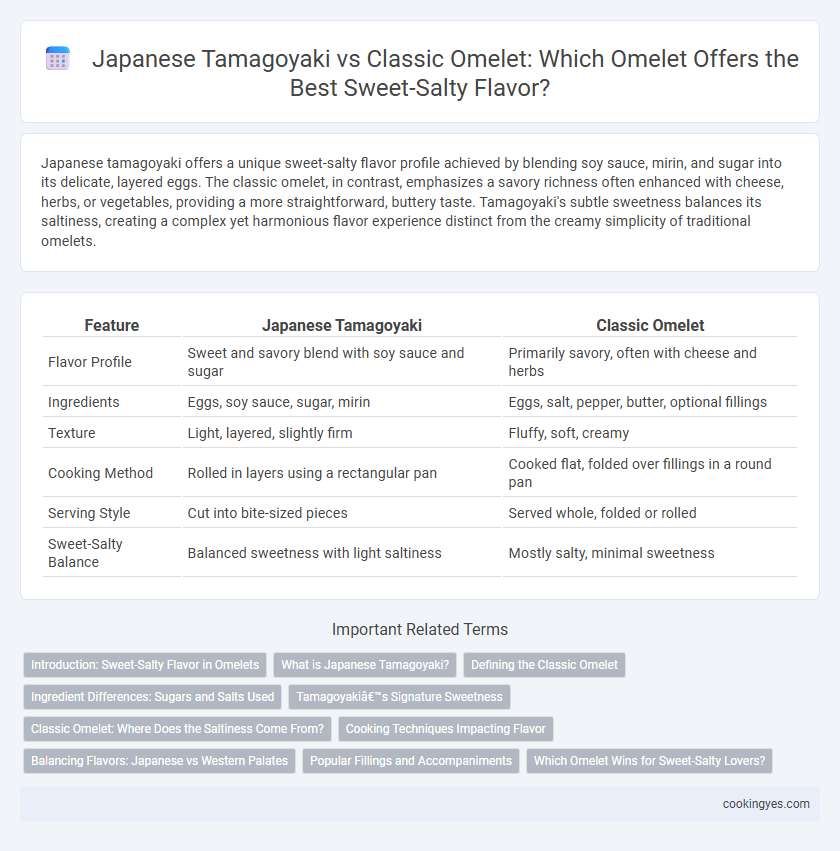Japanese tamagoyaki offers a unique sweet-salty flavor profile achieved by blending soy sauce, mirin, and sugar into its delicate, layered eggs. The classic omelet, in contrast, emphasizes a savory richness often enhanced with cheese, herbs, or vegetables, providing a more straightforward, buttery taste. Tamagoyaki's subtle sweetness balances its saltiness, creating a complex yet harmonious flavor experience distinct from the creamy simplicity of traditional omelets.
Table of Comparison
| Feature | Japanese Tamagoyaki | Classic Omelet |
|---|---|---|
| Flavor Profile | Sweet and savory blend with soy sauce and sugar | Primarily savory, often with cheese and herbs |
| Ingredients | Eggs, soy sauce, sugar, mirin | Eggs, salt, pepper, butter, optional fillings |
| Texture | Light, layered, slightly firm | Fluffy, soft, creamy |
| Cooking Method | Rolled in layers using a rectangular pan | Cooked flat, folded over fillings in a round pan |
| Serving Style | Cut into bite-sized pieces | Served whole, folded or rolled |
| Sweet-Salty Balance | Balanced sweetness with light saltiness | Mostly salty, minimal sweetness |
Introduction: Sweet-Salty Flavor in Omelets
Japanese tamagoyaki offers a unique sweet-salty flavor profile achieved by blending soy sauce, mirin, and sugar with beaten eggs, creating a delicate balance of umami and sweetness. In contrast, classic omelets often rely on salt, pepper, and occasionally cheese or herbs to enhance the savory taste, resulting in a predominantly salty flavor without the distinct sweetness found in tamagoyaki. This flavor distinction highlights the cultural differences in seasoning preferences and culinary techniques between Japanese and Western omelet traditions.
What is Japanese Tamagoyaki?
Japanese tamagoyaki is a multilayered omelet made by rolling together several thin layers of seasoned egg, often incorporating soy sauce and sugar for a balanced sweet-salty flavor. Unlike the classic omelet, which is typically fluffy and savory, tamagoyaki achieves a delicate texture with a subtly sweet and umami-rich taste profile. Its preparation requires specialized rectangular pans and precise cooking techniques, resulting in a unique, slightly sweet omelet distinct from Western versions.
Defining the Classic Omelet
The classic omelet is defined by its fluffy texture and savory taste, achieved through whisking eggs with salt and cooking them gently in butter or oil. Unlike Japanese tamagoyaki, which layers sweet and salty flavors by combining eggs with sugar, soy sauce, and mirin, the classic omelet emphasizes a balanced, mildly salty profile that complements various fillings such as cheese, herbs, or ham. Its simplicity and versatility make the classic omelet a staple breakfast dish in Western cuisine, highlighting natural egg flavor without the pronounced sweetness found in tamagoyaki.
Ingredient Differences: Sugars and Salts Used
Japanese tamagoyaki features a distinctive sweet-salty flavor achieved by incorporating both sugar and soy sauce into its egg mixture, with mirin often adding subtle sweetness. Classic omelets typically rely on a pinch of salt and sometimes herbs, with no added sugars, resulting in a more savory profile. The use of sugars and fermented soy-based seasonings in tamagoyaki creates a balanced taste that contrasts with the straightforward salt seasoning in traditional Western omelets.
Tamagoyaki’s Signature Sweetness
Japanese tamagoyaki is renowned for its signature sweetness, achieved by blending soy sauce, mirin, and sugar into the egg mixture. This sweet-salty balance sets it apart from the classic Western omelet, which typically emphasizes savory ingredients like cheese, herbs, and vegetables. The delicate layers and slightly caramelized exterior of tamagoyaki enhance its unique flavor profile, making it a distinct culinary experience.
Classic Omelet: Where Does the Saltiness Come From?
The saltiness in a classic omelet primarily comes from the addition of seasoned ingredients such as cheese, ham, or salted butter, which enhance its savory profile. Unlike Japanese tamagoyaki, which balances sweetness with mirin and sugar, the classic omelet relies on these salty components to create its distinctive flavor. The use of salt and savory fillings in the classic omelet ensures a rich, umami-packed taste that contrasts with the tamagoyaki's subtle sweet notes.
Cooking Techniques Impacting Flavor
The Japanese tamagoyaki's layered cooking technique, using multiple thin egg layers folded together, creates a tender texture with a balanced sweet-salty flavor from sugar and soy sauce infusion. In contrast, the classic omelet employs a single, gently folded egg layer, resulting in a fluffier texture with a predominantly savory taste enhanced by butter and salt. These distinct cooking methods directly influence the flavor profiles and mouthfeel, showcasing how technique shapes culinary experience.
Balancing Flavors: Japanese vs Western Palates
Japanese tamagoyaki achieves a delicate balance between sweet and salty through the use of mirin and soy sauce, creating a layered umami flavor preferred in Japanese cuisine. Classic Western omelets typically emphasize savory ingredients like cheese, ham, and vegetables, with salt and pepper enhancing the flavor without overt sweetness. The contrast in flavor profiles highlights Japanese tamagoyaki's subtle sweetness as a key element for balancing tastes, while Western omelets focus on bold, savory richness aligned with Western palates.
Popular Fillings and Accompaniments
Japanese tamagoyaki features a sweet-salty flavor achieved by blending soy sauce, mirin, and sugar, offering a delicate taste profile compared to the richer, buttery classic omelet. Popular fillings for tamagoyaki include finely chopped scallions, seaweed, or diced fish, enhancing its umami character, whereas classic omelets often incorporate ingredients like cheese, ham, and bell peppers, emphasizing a creamy and savory experience. Traditional accompaniments for tamagoyaki include pickled vegetables and steamed rice, while classic omelets pair well with toasted bread, fresh herbs, and breakfast potatoes.
Which Omelet Wins for Sweet-Salty Lovers?
Japanese tamagoyaki features layers of slightly sweetened eggs seasoned with soy sauce and mirin, delivering a delicate balance of sweet and salty flavors that melt in your mouth. Classic omelets typically emphasize savory notes with ingredients like cheese, ham, or herbs, offering a more straightforward salty profile without inherent sweetness. For sweet-salty lovers, tamagoyaki wins by combining subtle sweetness and umami-rich saltiness in a harmonious, tender texture unmatched by traditional Western omelets.
Japanese tamagoyaki vs Classic omelet for sweet-salty flavor Infographic

 cookingyes.com
cookingyes.com